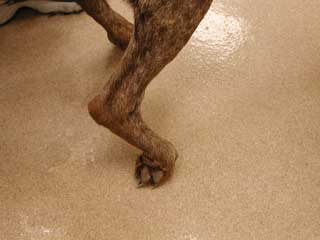As I was performing an exam on a senior dog, the client questioned one of the tests I used to determine the cause of her pet's hind end weakness.
For the test, I flipped his feet over one at a time while he was standing, to test something called "conscious proprioception", which means I was determining whether he was aware that his feet were upside down. Most dogs will immediately flip their foot back to a normal position and will not stand on a leg with the toes flipped over. If they have decreased nerve function, the foot will have "numb" areas where the dog does not get the signal that they are standing on the top of the toes instead of the bottom. They will leave the foot in the turned-under position. Depending on the degree of nerve damage, the dog may be slow to place the foot back in a normal position or may actually stand, bearing weight on the top of the foot.
Other tests of nerve function in the legs may include gentle pinching along the toes and different aspects of the leg. Individual nerves can be tested, depending on the area touched, as each nerve supplies different areas.
While we do see decreased nerve function in older dogs, it is not an automatic event just due to aging. It always signals damage along the spinal cord or to individual nerves. The damage can be related to trauma, degenerative diseases, or inflammatory diseases.
While many pet owners would see these changes as a signal to decrease exercise for their pets, it's actually very important to keep these pets moving. Strong muscles support the joints. Physical therapy and controlled exercise will stimulate the degenerating nerves and can delay decline in function. Walking on "tactile" surfaces with texture instead of slick floors will stimulate sensation in the feet. Obviously, animals should not be pushed past their comfort zone when exercising and feet should be protected so sores do not develop and toenails are not worn to the point of damage or pain. Toe grips may provide a little protection to the nails and will help the dog "grab" the walking surface. Other dogs may need more protection from boots, wraps, or braces to keep the foot in an upright position.
Supplements may help improve nerve function and strengthen muscle. Antioxidants and Omega 3 fatty acids can also support healthy nerve function. Acupuncture, specifically electro-acupuncture, chiropractic care, and herbal remedies can be very effective treatments for pets suffering from nerve dysfunction.
Disclaimer: This content is for informational purposes only and is not meant to diagnose, treat, or replace consulting a primary veterinarian for individualized care.

